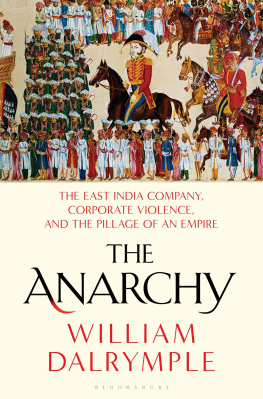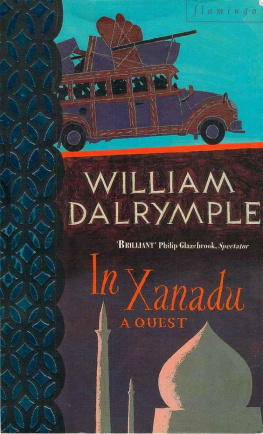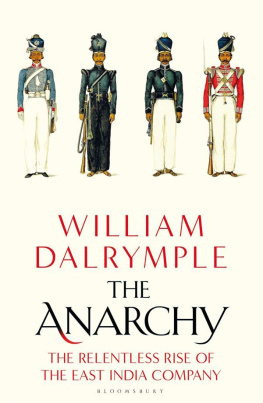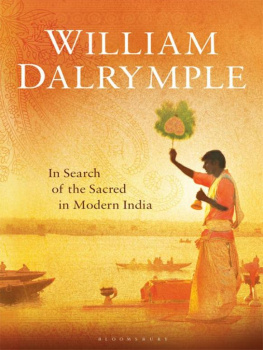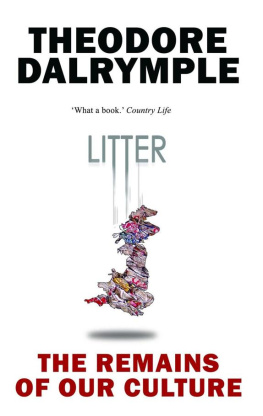From the
Holy Mountain
A JOURNEY
IN THE SHADOW OF
BYZANTIUM

WILLIAM DALRYMPLE

For my parents
with love and gratitude
Table of Contents
My cell is bare and austere. It has white walls and a flagstone floor. Only two pieces of furniture break the severity of its emptiness: in one corner stands an olive-wood writing desk, in the other an iron bedstead. The latter is covered with a single white sheet, starched as stiff as a nuns wimple.
Through the open window I can see a line of black habits: the monks at work in the vegetable garden, a monastic chain-gang hoeing the cabbage patch before the sun sets and the wooden simandron calls them in for compline. Beyond the garden is a vineyard, silhouetted against the bleak black pyramid of the Holy Mountain.
All is quiet now but for the distant breaking of surf on the jetty and the faint echo and clatter of metal plates in the monastery kitchens. The silence and solemnity of the place is hardly designed to raise the spirits, but you could hardly find a better place to order your mind. There are no distractions, and the monastic silence imposes its own brittle clarity.
Its now nine oclock. The time has finally come to concentrate my thoughts: to write down, as simply as I can, what has brought me here, what I have seen, and what I hope to achieve in the next few months.
My reference books are laid out in a line on the floor; the pads containing my library notes are open. Files full of photocopied articles lie piled up below the window; my pencils are sharpened and upended in a glass. A matchbox lies ready beside the paraffin storm lantern: the monastery generator is turned off after compline, and if am to write tonight I will have to do so by the light of its yellow flame.
Open on the desk is my paperback translation of The Spiritual Meadow of John Moschos, the unlikely little book which first brought me to this monastery, and the original manuscript of which I saw for the first time less than one hour ago. God willing, John Moschos will lead me on, eastwards to Constantinople and Anatolia, then southwards to the Nile and thence, if it is still possible, to the Great Kharga Oasis, once the southern frontier of Byzantium.
This morning, six days after leaving the damp of a dreich Scottish June, I caught ship from Ouranoupolis, the Gate of Heaven, down the peninsula to the Holy Mountain.
We passed a monastic fishing boat surrounded by a halo of seagulls. Opposite me, three large monks in ballooning cassocks sat sipping cappuccinos under an icon of the Virgin; over their grey moustaches there rested a light foam of frothed milk. Behind them, through the porthole, you could see the first of the great Athonite monasteries rising up from sandy bays to crown the foothills of the mountain. They are huge complexes of buildings, great ash-coloured fortresses the size of small Italian hill-towns, with timber-laced balconies hanging below domed cupolas and massive, unwieldy medieval buttresses.
The first monastic foundation on Athos was established in the ninth century by St Euthymius of Salonica who, having renounced the world at the age of eighteen, took to moving around on all fours and eating grass; he later became a stylite, and took to berating his brethren from atop a pillar. Some two hundred years later by which time St Euthymiuss fame had led to many other monasteries and sketes springing up around the saints original foundation it came to the ears of the Byzantine Emperor that the monks were in the habit of debauching the daughters of the shepherds who came to the mountain to sell milk and wool. Thereafter it was decreed that nothing female no woman, no cow, no mare, no bitch could step within its limits.
Today this rule is relaxed only for cats, and in the Middle Ages even a pair of Byzantine Empresses were said to have been turned away from the Holy Mountain by the Mother of God herself. But 140 years ago, in 1857, the Virgin was sufficiently flexible to allow one of my Victorian great-aunts, Virginia Somers, to spend two months in a tent on Mount Athos, along with her husband and the louche Pre-Raphaelite artist Coutts Lindsay. A letter Virginia wrote on her visit still survives, in which she describes how the monks had taken her over the monastery gardens and insisted on giving her fruit from every tree as they passed; she said she tasted pomegranate, citron and peach. It is the only recorded instance of a woman being allowed onto the mountain in the millennium-long history of Athos, and is certainly the only record of what appears to have been a most unholy Athonite mnage--trois.
This unique lapse apart, the Holy Mountain is still a self-governing monastic republic dedicated to prayer, chastity and pure, untarnished Orthodoxy. At the Council of Florence in 1439 it was Athonite monks who refused to let the Catholic and Orthodox Churches unite in return for Western military help against the Turk; as a result Constantinople fell to the Ottomans within two decades, but Orthodoxy survived doctrinally intact. That deep pride in Orthodoxy combined with a profound suspicion of all other creeds remains the defining ideology of Athos today.
I disembarked at Daphne, caught the old bus to the monastic capital at Karyes, then walked slowly down the ancient foot-polished cobbles, through knee-high sage and clouds of yellow butterflies, to the lavra of Iviron.
The monks had just finished vespers. As it was a lovely balmy evening, many were standing around the courtyard enjoying the shade of the cypresses next to the katholikon. Fr. Yacovos, the guestmaster, was sitting on the steps of the domed Ottoman fountain, listening to the water dripping from the spout into the bowl. He stood up when he saw me enter the courtyard.
Welcome, he said. Weve been expecting you.
Yacovos was a garrulous, thick-set, low-slung monk, bearded like a brigand. On his head, tilted at a jaunty angle, sat a knitted black bonnet. He took my bags and led me to the guest room, where he poured a glass of ouzo and offered me a bowl full of rose-scented loukoumi. As he did so, he chattered happily about his life in the merchant navy. He had visited Aberdeen on a Cypriot ship in the winter of 1959, he said, and had never forgotten the fog and the bitter cold. I asked where I could find the librarian, Fr. Christophoros. It had been Fr. Christophoross letter surmounted by the great Imperial crest, the double-headed eagle of Byzantium that had originally lured me to Athos. The manuscript I was looking for was in Ivirons monastic library, he had said. Yes, it had survived, and he would try to get the Abbots permission for me to see it.
Christophoros will be down at the Arsenal at this time, said Fr. Yacovos, looking at his fob watch, feeding his cats.
I found the old man standing on the jetty, holding a bucket full of fishtails. A pair of enormous black spectacles perched precariously on his nose. Around him swirled two dozen cats.
Come, Justinian, called Fr. Christophoros. Come now, Chrysostom, wisswisswisswiss Come on, my darlings, ela, come
I walked up and introduced myself.
We thought you were coming last week, replied the monk, a little gruffly.
Im sorry, I said. I had trouble getting a permit in Thessaloniki.


